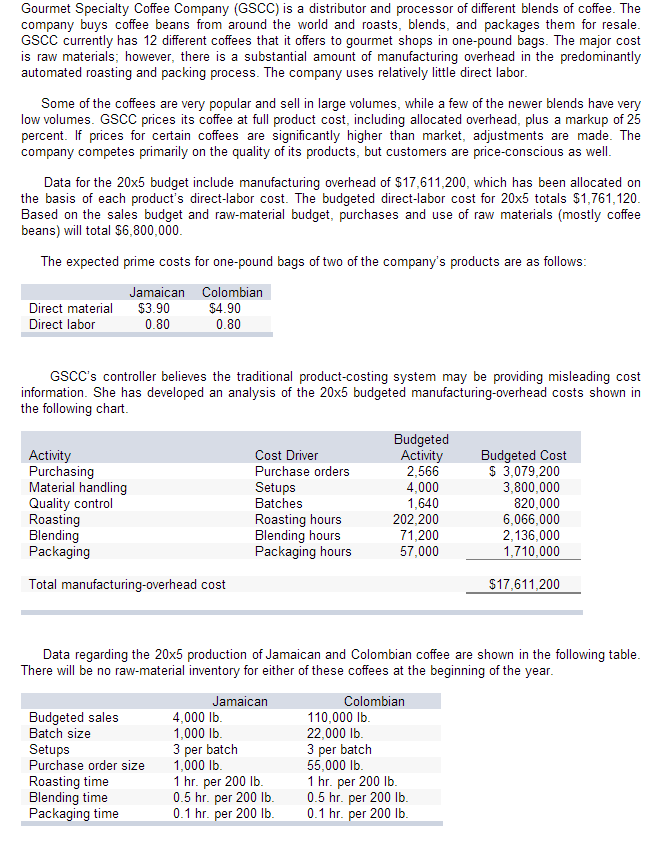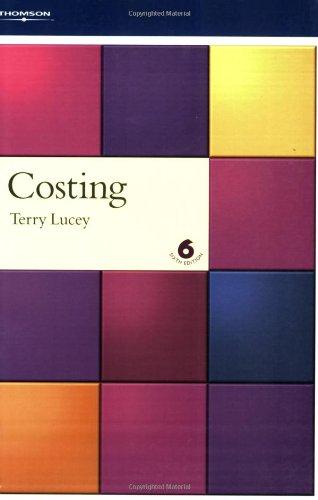

Gourmet Specialty Coffee Company (GSCC) is a distributor and processor of different blends of coffee. The company buys coffee beans from around the world and roasts, blends, and packages them for resale. GSCC currently has 12 different coffees that it offers to gourmet shops in one-pound bags. The major cost is raw materials; however, there is a substantial amount of manufacturing overhead in the predominantly automated roasting and packing process. The company uses relatively little direct labor. Some of the coffees are very popular and sell in large volumes, while a few of the newer blends have very low volumes. GSCC prices its coffee at full product cost, including allocated overhead, plus a markup of 25 percent. If prices for certain coffees are significantly higher than market, adjustments are made. The company competes primarily on the quality of its products, but customers are price-conscious as well. Data for the 20times5 budget include manufacturing overhead of $17.611.200. which has been allocated on the basis of each product's direct-labor cost. The budgeted direct-labor cost for 20times5 totals $1,761,120. Based on the sales budget and raw-material budget, purchases and use of raw materials (mostly coffee beans) will total $6,800,000. The expected prime costs for one-pound bags of two of the company's products are as follows: GSCC's controller believes the traditional product-costing system may be providing misleading cost information. She has developed an analysis of the 20 times 5 budgeted manufacturing-overhead costs shown in the following chart. Data regarding the 20 times 5 production of Jamaican and Colombian coffee are shown in the following table. There will be no raw-material inventory for either of these coffees at the beginning of the year. Calculate a new product cost, using an activity-based costing approach, for one pound of Jamaican coffee and one pound of Colombian coffee. Assume ending inventory for both the varieties of coffee is zero (Round your intermediate calculations and final answers to 2 decimal places.) Gourmet Specialty Coffee Company (GSCC) is a distributor and processor of different blends of coffee. The company buys coffee beans from around the world and roasts, blends, and packages them for resale. GSCC currently has 12 different coffees that it offers to gourmet shops in one-pound bags. The major cost is raw materials; however, there is a substantial amount of manufacturing overhead in the predominantly automated roasting and packing process. The company uses relatively little direct labor. Some of the coffees are very popular and sell in large volumes, while a few of the newer blends have very low volumes. GSCC prices its coffee at full product cost, including allocated overhead, plus a markup of 25 percent. If prices for certain coffees are significantly higher than market, adjustments are made. The company competes primarily on the quality of its products, but customers are price-conscious as well. Data for the 20times5 budget include manufacturing overhead of $17.611.200. which has been allocated on the basis of each product's direct-labor cost. The budgeted direct-labor cost for 20times5 totals $1,761,120. Based on the sales budget and raw-material budget, purchases and use of raw materials (mostly coffee beans) will total $6,800,000. The expected prime costs for one-pound bags of two of the company's products are as follows: GSCC's controller believes the traditional product-costing system may be providing misleading cost information. She has developed an analysis of the 20 times 5 budgeted manufacturing-overhead costs shown in the following chart. Data regarding the 20 times 5 production of Jamaican and Colombian coffee are shown in the following table. There will be no raw-material inventory for either of these coffees at the beginning of the year. Calculate a new product cost, using an activity-based costing approach, for one pound of Jamaican coffee and one pound of Colombian coffee. Assume ending inventory for both the varieties of coffee is zero (Round your intermediate calculations and final answers to 2 decimal places.)








